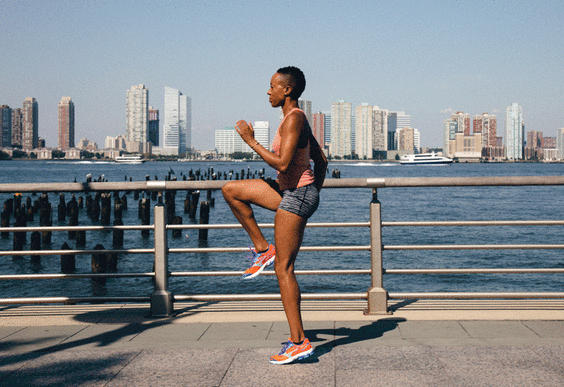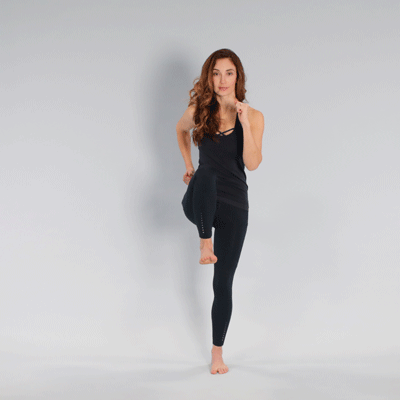High knees is a deceptively simple exercise that exaggerates basic running form to challenge multiple muscle groups — primarily the large lower-body muscles.
What are the benefits of high knees?
The explosive action of high knees gets your heart pumping for greater cardiovascular health while activating the quadriceps, calves, hamstrings, and glutes. It also juices the hips, abs, and upper body.
However, it’s also a plyometric exercise that improves your neuromuscular efficiency, which translates into improved acceleration, agility, and overall speed. You’re training your body in a specific movement pattern (running) but in a biomechanically correct way at functional speed. In short — you’re training your body to run better.
That’s some pretty good returns for one move you can do in your living room. Read on to learn more.
How to do high knees (and variations)
You don’t need equipment to do high knees, nor do you need a lot of exercise space. For beginners, it’s better to do high knees without any forward movement to help train your body to execute the correct form.
Always start any variation of high knees with a tight, activated core. You can do that by pulling your belly button toward your spine. You should still be able to breathe freely, but that tight core supports your body and reduces the chances of injury.
Standard high knees

High knees should look like exaggerated running. It makes a great warmup exercise, part of a circuit, or HIIT workout.
- Start with your feet slightly apart, with your weight centered over the balls of your feet.
- Lift your left knee as high as comfortably possible and bring the heel toward your glutes.
- Drive your left knee and foot back toward the ground as you lift your right knee as high as possible and bring the right heel toward your glutes.
- Drive your right knee back toward the ground as you lift your left knee as in step 3.
- Be sure to pump your arms in normal running form. This will help you gather enough momentum to keep your knees high, even after you start getting winded.
- Repeat for 10 seconds, slowly extending the time you do the exercise.
Pro tips:
- The goal of high knees isn’t to cover a lot of ground. It’s to lift the knees as high as possible as quickly as possible. You may only move forward a few inches, or not at all if you’re in your living room, and that’s OK.
- Your footfalls should be light and quick. Focus on your landings rather than your knees to build more speed. (Or go back to kindergarten and pretend the ground is hot lava. Many a runner has gotten faster to avoid getting burned.)
- Move your arms as though you were running. Arm motions help build speed, too, and activate the upper body.
High knees with a twist (steam engine)
Make your hip flexors and abdominals work even harder with this high knee variation.
- Start with your feet slightly apart and hands behind your head with fingers interlocked.
- Lift your left knee. While keeping your hands behind your head, twist to bring your right elbow toward your left knee.
- Drive your left knee and foot back toward the ground.
- Lift your right knee as you twist to bring the left elbow toward the right knee.
- Drive the right knee and foot back toward the ground. That’s one rep.
- Repeat. All in all, you can decide how many alternations you want to include in a set. For example, one knee-lift on either side can = 1 rep, or 2 lifts can = 1 rep, and so on.
Pro tip: This is an advanced version of high knees. Only attempt steam engines after having mastered the standard high knee exercise.
High knee march

High knees are a high-impact exercise. So, if you’ve got bad knees or foot or ankle injuries, this exercise can actually aggravate things. High knee march is a low-impact version, that if done correctly, can still give you a good cardio workout and build power.
Follow the directions for standard high knees. However, instead of bouncing off the ground in a running motion, slow down and march. You’re still exploding with each step, but you’re not putting as much stress on your knees. Make sure to land gently.
Pro tip: You’ll get a better workout if you pump your arms harder.
Plyometric skip

Plyometric skips or plyo skips add another level of balance and power to standard high knees.
- Start with the feet slightly apart, with the arms at a 90-degree angle.
- Press your left foot into the ground and jump while driving your right knee high and right heel toward the glutes. (Use running arm motions to help drive you upward.)
- Land lightly on your left foot and skip.
- Drive the right foot into the ground and (explosively) jump while pulling the left knee high and left foot toward your glutes.
- Land lightly on the right foot and skip.
- Repeat step 2 and continue 10 to 20 seconds. As you progress, you can work your way up to 30- to 60-second sets.
Pro tip: Speed and distance aren’t the point of plyo skips. The goal is to jump as high as you can on each skip, exploding off the ground to build power. You can even do them in place.
Where you feel the burn
High knees target the major lower body muscle groups that you’d expect — glutes, quads, calves, and hamstrings. However, it really puts your hip flexors, the muscles that raise your knees, to work. The abs get involved, too, especially if you activate them before you start.
If you want to get faster and improve your acceleration, plyometric exercises like high knees are vital. You’re building explosive power and speed while raising your heart rate.
Arm motions are important as well. Here, you work the shoulders (lats), biceps, and pectoral muscles, which also influence your speed. When you increase movement in the upper and lower body, you increase the stresses put on your core to stabilize the body. (Can you see where this is headed?) Namely, when you get those knees going, you’re pushing yourself into a functional, full-body exercise.
Tips to avoid injury
- Start stationary. If you’re new to high knees, begin doing them in place before doing them while moving forward. Starting slow gives you time to develop proper form — tight core, straight back, knees rising high — before adding speed.
- Mind your surfaces. This exercise has you landing on one foot. You can easily twist an ankle on an uneven surface. Also, different surfaces put different impacts on the joints. For example, doing high knees on grass will actually put more stress on your joints than doing them on concrete.
- This is a no-no if you have knee problems. High knees puts a lot of stress on the knee and ankle joints. The low-impact marching variation may be a possibility if it doesn’t bother you. But if you have an ankle or foot injury, it’s best to say no to this high-impact exercise.
What to do if injury does strike
Though beneficial, plyometric exercises like high knees tend to have a higher-than-average injury rate, due to their high-impact nature being hard on the joints.
If you do end up getting an injury, don’t let it discourage you from exercise, but also be wise about how you proceed. For example, you should never ignore nagging pain in your knees, ankles, or feet. Wait until the pain is gone before doing high knees again.
And don’t do high knees if you’re coming back from an injury until your doctor gives the OK. This is an advanced move that can do some damage if done incorrectly or too soon after an injury. When you do try again, go slow. Try marching first before turning high knees into a running exercise again.
Bottom line
High knees pack a lot of impact in a simple package. When done right and consistently, you’ll see a lot of benefits related to explosiveness, flexibility, and endurance.
Newbies, be sure to work your way into the more difficult variations, speeds, and intensity levels of this exercise. Gradual increases give your body time to adapt and strengthen itself to avoid injury.

0 Commentaires